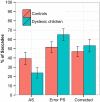Impaired Oculomotor Behavior of Children with Developmental Dyslexia in Antisaccades and Predictive Saccades Tasks
- PMID: 27445945
- PMCID: PMC4927629
- DOI: 10.3389/fpsyg.2016.00987
Impaired Oculomotor Behavior of Children with Developmental Dyslexia in Antisaccades and Predictive Saccades Tasks
Abstract
Analysis of eye movement patterns during tracking tasks represents a potential way to identify differences in the cognitive processing and motor mechanisms underlying reading in dyslexic children before the occurrence of school failure. The current study aimed to evaluate the pattern of eye movements in antisaccades, predictive saccades and visually guided saccades in typical readers and readers with developmental dyslexia. The study included 30 children (age M = 11; SD = 1.67), 15 diagnosed with developmental dyslexia (DG) and 15 regular readers (CG), matched by age, gender and school grade. Cognitive assessment was performed prior to the eye-tracking task during which both eyes were registered using the Tobii® 1750 eye-tracking device. The results demonstrated a lower correct antisaccades rate in dyslexic children compared to the controls (p < 0.001, DG = 25%, CC = 37%). Dyslexic children also made fewer saccades in predictive latency (p < 0.001, DG = 34%, CG = 46%, predictive latency within -300-120 ms with target as 0 point). No between-group difference was found for visually guided saccades. In this task, both groups showed shorter latency for right-side targets. The results indicated altered oculomotor behavior in dyslexic children, which has been reported in previous studies. We extend these findings by demonstrating impaired implicit learning of target's time/position patterns in dyslexic children.
Keywords: antisaccades; dyslexia; eye movements; implicit learning; predictive saccades.
Figures




Similar articles
-
Dyslexic and normal readers' eye movements.J Exp Psychol Hum Percept Perform. 1983 Oct;9(5):816-25. doi: 10.1037//0096-1523.9.5.816. J Exp Psychol Hum Percept Perform. 1983. PMID: 6227691
-
Binocular saccade coordination in reading and visual search: a developmental study in typical reader and dyslexic children.Front Integr Neurosci. 2014 Oct 30;8:85. doi: 10.3389/fnint.2014.00085. eCollection 2014. Front Integr Neurosci. 2014. PMID: 25400559 Free PMC article.
-
Differences in eye movements and reading problems in dyslexic and normal children.Vision Res. 1994 May;34(10):1345-58. doi: 10.1016/0042-6989(94)90209-7. Vision Res. 1994. PMID: 8023443
-
Visual training could be useful for improving reading capabilities in dyslexia.Appl Neuropsychol Child. 2021 Jul-Sep;10(3):199-208. doi: 10.1080/21622965.2019.1646649. Epub 2019 Aug 13. Appl Neuropsychol Child. 2021. PMID: 31407599 Review.
-
Infant brain responses associated with reading-related skills before school and at school age.Neurophysiol Clin. 2012 Jan-Feb;42(1-2):35-41. doi: 10.1016/j.neucli.2011.08.005. Epub 2011 Sep 17. Neurophysiol Clin. 2012. PMID: 22200340 Review.
Cited by
-
Vestibular Function in Children with Neurodevelopmental Disorders: A Systematic Review.J Autism Dev Disord. 2019 Aug;49(8):3328-3350. doi: 10.1007/s10803-019-04059-0. J Autism Dev Disord. 2019. PMID: 31102194
-
Educational and Cognitive Predictors of Pro- and Antisaccadic Performance.Front Psychol. 2017 Nov 20;8:2009. doi: 10.3389/fpsyg.2017.02009. eCollection 2017. Front Psychol. 2017. PMID: 29209249 Free PMC article.
-
Developmental Eye Movement test and dyslexic children: A pilot study with eye movement recordings.PLoS One. 2018 Sep 7;13(9):e0200907. doi: 10.1371/journal.pone.0200907. eCollection 2018. PLoS One. 2018. PMID: 30192750 Free PMC article.
-
Eye movements and postural control in dyslexic children performing different visual tasks.PLoS One. 2018 May 24;13(5):e0198001. doi: 10.1371/journal.pone.0198001. eCollection 2018. PLoS One. 2018. PMID: 29795687 Free PMC article.
-
Eye Tracking-Based Characterization of Fixations during Reading in Children with Neurodevelopmental Disorders.Brain Sci. 2024 Jul 26;14(8):750. doi: 10.3390/brainsci14080750. Brain Sci. 2024. PMID: 39199445 Free PMC article.
References
-
- Bates D., Mächler M., Bolker B. M., Walker S. C. (2015). Fitting linear mixed-effects models using lme4. J. Stat. Softw. 67, 1–48. 10.18637/jss.v067.i01 - DOI
LinkOut - more resources
Full Text Sources
Other Literature Sources

